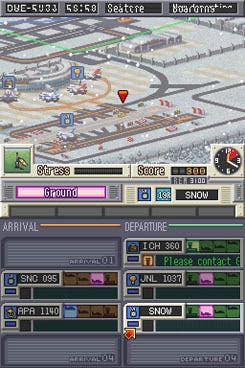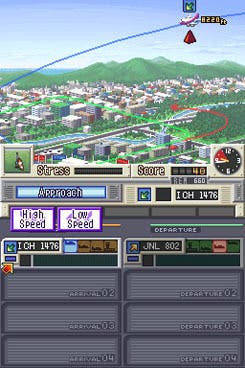Air Traffic Chaos
Business class.
You'll be simultaneously managing departures. Once boarding's done, you need to confirm the plane's route, assign it a runway, wait for a pushback from a tug (and for the tug to return to base), clear it to taxi, give permission to cross if necessary, clear it for takeoff, and tell it to contact the departure radio channel.
Got that? Now consider you could be managing up to four arrivals and four departures, at various stages (or if you're really unlucky or inept, the same stages) at any one time. You need to manage the speed of craft in the air to avoid collisions, and keep an eye on slotting arriving planes into the holding pattern without mishap. You need to manage runway time to get everything on the ground and in the air without chokepoints, traffic jams or tailwinds.
And, perhaps trickiest of all, you need to manage the busy taxiways and gates for arriving and departing aircraft, avoiding ground collisions or long waits for a free gate for arrivals. This blocks further landings on that runway, which will often, due to the wind, be the only one you can use, as well as causing pilots a high level of stress.
Ah yes - we haven't mentioned stress. Pilots' stress increases according to how long they have to wait for their next instruction. Each plane has an individual stress meter, and there's an overall stress gauge that will fail you if it reaches maximum. Stress builds up quicker for some things (waiting for an arrivals gate) than others (assigning a departure runway), and can be mitigated to some extent by reassuring pilots with "hold" instructions. You won't want to do that too much though, as it ties up radio time.

Right, yeah, radio time. You won't fall afoul of this too much in the earlier levels, but this is where the fun really starts (or rather, doesn't) later on. You have four radio channels - Approach (speed control and runway allocation for planes arriving and in the holding pattern), Tower (speed control for planes assigned a runway to land or on the approach, confirming and aborting landings, clearance to takeoff, contacting departure), Ground (gate allocations for arrivals, runway allocations for departures, clearance to taxi, permission to cross) and Delivery (confirm route for departures).
Each can only issue one instruction to one aircraft at a time, and a typical instruction can take fifteen or twenty precious seconds to transmit. Learning to assign your radio time carefully - balancing it against how long it takes planes to respond and start in on their instructions - is critical to success at higher difficulties. Ground is a tremendous organisational bottleneck, while a non-essential "hold" command issued over Approach at the wrong moment can leave you unable to make a critical speed change to stop a collision. All you can do is stare, appalled and powerless, as the radio chatters away and you wait for the air crash to happen.
It's frantic, intense, requires an organised mind, the ability to shuffle priorities and information at high speed and - most importantly and most improbably of all - a resistance to the stress generated by flashing boxes and alarm sounds. Thankfully the touch-screen interface is extremely fast (d-pad and buttons also work well enough for compulsive playing with gloved hands on cold train platforms, I found) and the retro, 16-bitty graphics are faultlessly precise. You cannot, ever, blame the game. You can only blame yourself, and you can only erase the burdensome guilt and furious frustration by hitting restart and trying, once again, to bring order to Japan's skies.

Playing Air Traffic Chaos is exactly like having a very busy day at work. It really is debatable whether it's enjoyable at all, and there's a constant, nagging fear that the knife-edge balance between order and chaos is going to tip at any time. At its worst, you can find yourself paralysed by the fear, simply watching in impotent misery as the boxes flash and the little pixel-planes spiral into destructive patterns.
But it's a mighty adrenaline rush, no doubt, and surviving its trials offers a bitter kind of satisfaction, as well as a warmer glow of hard-earned self-worth. Better than that, the system is so impeccably balanced and designed - and the 15 strictly scripted stages are put together with such care - that, when everything comes together and you play a hard stage well, it takes on the deep, intricate beauty of the greatest game of Tetris you ever played.
Air Traffic Chaos is CakeMania for anoraks: a basic, bizarrely unglamorous, stern and unloving mistress that you just cannot bring yourself to leave, to stop wanting to please. The extras, options, and number of stages are a slap in the face, the rewards pitiful and the pain great, but you won't care; and you'll spend dozens of hours compulsively playing it, more than you will many other more lavish and entertaining DS games. I struggled for a long time to come up with a reason for this, but it might be as simple as this: Air Traffic Chaos is, basically, terribly, perfect.








